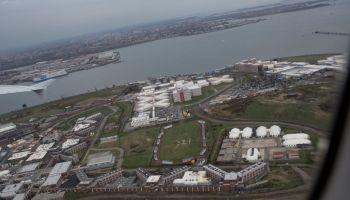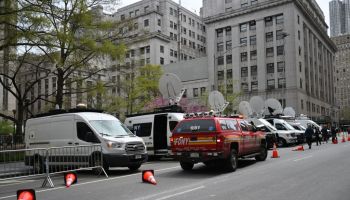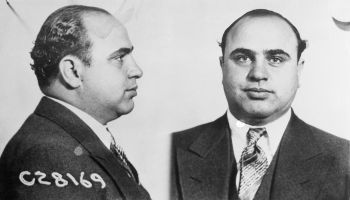VIA WASHINGTON POST:
It’s a renter’s dream: a swimming pool, a washer-dryer right in the apartment and a 24-hour Giant across the street. And at the foot of Wildwood Towers, a high-rise building off Columbia Pike in Arlington County, a glorious, free parking space.
The amenity that makes residents swoon is likely to disappear soon, though — along with thousands of parking spaces in office buildings and shopping districts across the county — under a plan heading toward approval next month by the county board. When you do park, you’ll pay what the market will bear.
The days when free or at least cheap parking in the suburbs was a right are waning fast. In an era of carbon footprints, greenhouse gases and crippling congestion, the goal of today’s planners and politicians is maximum inconvenience for drivers. The District is pulling up parking lots and putting in expensive meters to get drivers out of their cars and onto a train, bus, bike or their feet. Montgomery and Fairfax counties are thinking along similar lines, considering changes to codes to reduce the number of parking spaces builders have to include.
“What we’re seeing is a sea change,” said Rick Siebert, property management chief for Montgomery County’s parking division. “We want to support economic development, but the old system ended up with the roads too crowded and questions about quality of life.”
Montgomery, with plentiful Metro stations, has long promoted public-private subsidies to transit riders and other strategies to discourage driving in the county’s business districts. Forty-two percent of the people in downtown Silver Spring get there without a car, for example. But the County Council thinks it can do better and hired a consultant to overhaul the parking code. Two spaces for every condo, three for every 1,000 square feet of office space could soon be history.
Not so long ago, the suburbs couldn’t get enough parking. Now lots are “underparked” and need to be “unbundled” from the price of a townhouse or condominium, in the buzzwords of planners. Curbside meters should be priced for “performance.” If it cost $100 a day to park in Friendship Heights (a hypothetical price), drivers might reconsider.
A mini-city
Planners mapping out a new, pedestrian-friendly mini-city in Tysons Corner to dovetail with the Metrorail line under construction are proposing parking standards unheard of in Fairfax County, where three-car families are not unusual. Buildings near the four future train stations in Tysons will no longer have to have a minimum of parking. The code now calls for at least 2.6 spaces per 1,000 square feet of office space; stores must have up to six spaces per that area. Townhouses get 2.7 spaces each.
The District dumped its parking minimums last year, rewriting the zoning code for the first time in 50 years to set parking space according to demand in a particular neighborhood.
In another departure from tradition, Tysons will not only have fewer places to park, but businesses will also have to share spaces. Nightclubbers will park in the spaces defense contractors were in that morning. Considering that Tysons has more land devoted to cars than people — with approximately 167,000 parking spaces covering 40 million square feet — they’re big changes.
“For Fairfax, it’s cutting edge,” said Daniel Rathbone, the transportation planning chief in Fairfax. “We see it as an important component of making the new Tysons work. It’s probably pretty controversial.”
Lenders’ standards
Lenders have traditionally balked at financing projects unless they have enough parking, on the theory that a building with more space for cars will attract a higher-paying tenant than one with fewer. Garage parking can cost a developer up to $50,000 per space to build, though.
“Once you build it, you can’t add more,” said David F. Webb, a senior managing director at Cassidy & Pinkard Colliers, which finances office projects in the region. “The developer doesn’t want to build more parking than he needs. The lender says, ‘Can you prove to me this is enough?’ If you’re underparked, you’re stuck.”
Arlington might be the region’s most transit-friendly suburb, with 11 Metro stations. But Wildwood Towers isn’t near one of them. An express bus a block away can take residents up Columbia Pike to the Pentagon Metro station during rush hours. But taking public transit to work would be inconvenient for Sarah Brodfuehrer, 25, a Fairfax teacher who, with her roommate, searched for four months for a building that had a spot for her Toyota Corolla.
“If they started charging, it would certainly make me consider moving,” she said. “Parking can add hundreds of dollars to your rent.”
Fluctuating rates
The changes underway in Arlington also would allow parking prices to fluctuate depending on demand. Meters would be remotely monitored for parking space usage. The goal is 85 percent occupancy, said Wayne Wentz, the county’s chief of transportation engineering and operations. When it rises, the price will increase from 75 cents to $1.
Wentz says it’s too early to say how much higher prices could go. But the District is experimenting with the same technology in a pilot program for congested neighborhoods in Ward 6, including the streets near Nationals Park and Capitol Hill. The market-driven approach drives up the meter price to $35 for three hours on game days. Leaders in Georgetown are considering similar technology.
“It’s sending a signal to drivers that if you’re gonna drive, it’s uniformly going to cost you,” said Harriet Tregoning, the District’s planning director. “We don’t want everyone to think it’s great to drive because parking is free and available.”
Tregoning says drivers in the District are long overdue for some tough love: Just 63 percent of city households own a car. The national average is somewhere in the 90s, she said.
The city used to require developers to build four parking spaces for every 1,000 square feet of retail space. Now the standard is one space.
“Now we say to developers, look at the car ownership rate in the neighborhood and do something that’s commensurate,” Tregoning said. When a historic building rehabilitation is under review, planners discourage even a single space for each condo or store.
Going underground
Such changes are more radical in the suburbs, but planners in downtown Bethesda took parking policy in a new direction this year when they approved a new underground lot that will be built below stores and apartments. The code allows 1,600 spaces. The county decided on 1,150, and that’s taking into account the traffic generated by the Bethesda Row stores.
County Council member Nancy Floreen (D-At Large) said it’s easy for cities to constrict the parking supply, because so many people are served by Metro and bus lines. It’s more difficult for farther-out communities, though.
“We have within the county places that are urban,” Floreen said. “But they’re surrounded by suburbia.”
- South Sudan: Entertainment, Food, Languages, Places To Visit + More
- Algeria: Entertainment, Food, Languages, Places To Visit + More
- Tunisia: Entertainment, Food, Languages, Places To Visit + More
- Morocco: Entertainment, Food, Languages, Places To Visit + More
- Egypt: Entertainment, Food, Languages, Places To Visit + More














